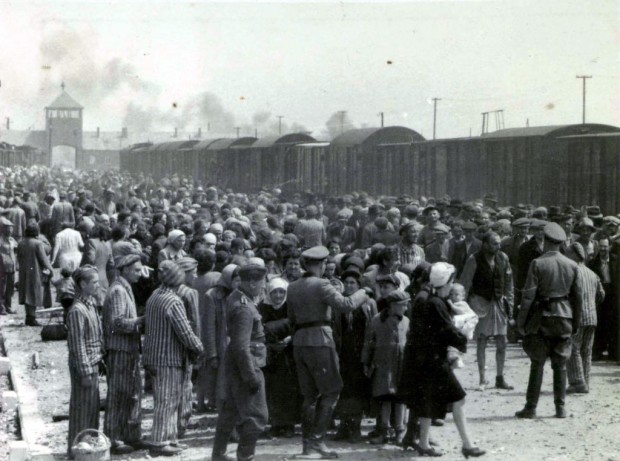Excerpts of musical compositions written by Auschwitz prisoners during the Holocaust were finally performed following lengthy restoration efforts helmed by 31-year-old composer Leo Geyer after his visit to Auschwitz in Poland.
Out of the 210 pieces of music discovered, four of the restored compositions were played by Constella Music, Geyer's production company, in an opera-ballet called "Orchestras of Auschwitz" as part of the organization's 10-year anniversary celebration. The performance was held at London's Sadler's Wells Theater last Monday, Nov. 27.

TOPSHOT - A photo taken 27 May 1944 in Oswiecim, showing Nazis selecting prisoners on the platform at the entrance of the Auschwitz-Birkenau extermination camp. The Auschwitz camp was established by the Nazis in 1940, in the suburbs of the city of Oswiecim which, like other parts of Poland, was occupied by the Germans during the Second World War. The name of the city of Oswiecim was changed to Auschwitz, which became the name of the camp as well. Over the following years, the camp was expanded and consisted of three main parts: Auschwitz I, Auschwitz II-Birkenau, and Auschwitz III-Monowitz. Red Army soldiers liberated the few thousand prisoners whom the Germans had left behind in the camp, 27 January 1945.
How Leo Geyer Found the Music Compositions
According to a report by CNN, Geyer visited the former Auschwitz concentration camp in 2015 in light of a commission to compose a score honoring the memory of the late Martin Gilbert, a British historian whose expertise revolved around the events of the Holocaust.
He wanted to fully understand the "sense of gravity" surrounding Gilbert's work when he chanced upon a meeting with an Auschwitz-Birkenau museum archivist, who then mentioned the existence of the musical fragments composed and performed by orchestras in Auschwitz.
"I nearly fell over when he first told me. I couldn't believe such a thing had gone almost unnoticed for almost 80 years," Geyer shared.
6 January 1941 | A small group of prisoners-musicians, who had received instruments from home, gathered in Block 24, where they held their first informal rehearsal in one of the rooms on the ground floor. This was the origin of the future camp orchestra. pic.twitter.com/j0oBjaC0x3
— Auschwitz Memorial (@AuschwitzMuseum) January 6, 2022
The composer returned to the site a month later for further inspection when he finally understood why people took no interest in the Auschwitz scores for the longest time. According to Geyer, the pieces were almost "obliterated" and the fragments that did remain needed to be deciphered because of the missing portions.
Geyer had then revisited Auschwitz a total of six times since his first visit in order to restore the uncovered music, laboring to do so by carrying out extensive research of Auschwitz testimonies and historical accounts in regard to music played in the concentration camps.
What he found out was that the majority of the camps employed orchestras made up of prisoners employing an improvised assemblage of readily available instruments, some of which are not commonly part of traditional orchestras like accordions and saxophones. One particular women's orchestra, however, includes the only cellist present at the time.
Anita Lasker-Wallfisch, the Lone Female Cellist at Birkenau
Cellist Anita Lasker-Wallfisch is a Holocaust survivor who is currently residing in Britain. Her grandson, Simon Wallfisch, was also part of the performance last Monday as a baritone, under Geyer's direction.
In an interview with the Holocaust Memorial Day, Lasker-Wallfisch recounted her experiences, saying, "That I survived nearly one year in Auschwitz is without any doubt due to the fact that I became a member of the camp orchestra." She continued by stating that so long as the Nazis desired music from an orchestra, musicians like her were safe from harm.

LONDON, UNITED KINGDOM: Holocaust survivor Anita Lasuer holds up a portrait of herself playing the cello taken in Berlin before WWII during an interview before the 60th anniversary of the liberation of Auschwitz 18 January 2005 in London. Lasuer survived Aucshwitz, in part, because she is a tallented cellist and playing in the camp orchestra.
The cellist shared that they would play for work commandos and the accompanying troops every morning and evening in order to keep the marches neatly in time. In addition, Lasker-Wallfisch said that their availability as musicians was a must for every single SS staff that requested to hear music, the same individuals who sent "thousands of people to their deaths."
In keeping with Geyer's research, he found out that many orchestras within the camps had also played in secret for the enjoyment of other prisoners. For them, it was akin to "a chink of daylight in the darkness."
Read More: Why Orchestras Employ a Lot More Violins Compared to Other Instruments



